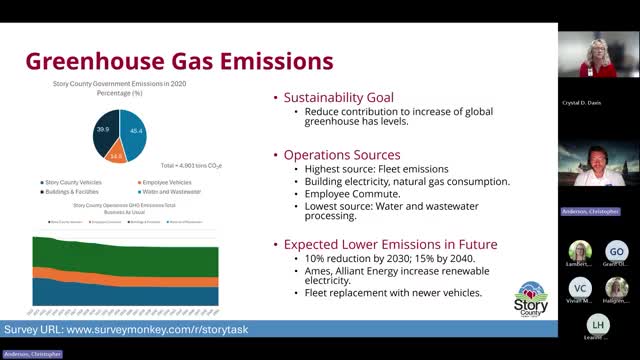Story County Government Sets Goals to Reduce Greenhouse Gas Emissions by 2030
October 01, 2025 | Story County, Iowa
This article was created by AI summarizing key points discussed. AI makes mistakes, so for full details and context, please refer to the video of the full meeting. Please report any errors so we can fix them. Report an error »

Story County officials are ramping up efforts to combat climate change, focusing on reducing greenhouse gas emissions that contribute to global warming. During a recent public meeting, the sustainability team highlighted the urgent need to address the rising levels of greenhouse gases, particularly their impact on local weather patterns and the Gulf of Mexico's water temperatures.
The meeting revealed that Story County's greenhouse gas emissions primarily stem from three sources: energy use in buildings and facilities (40%), county vehicles (45%), and employee commutes (14%). These figures underscore the importance of targeted actions to mitigate emissions.
A significant takeaway from the discussion was the projection of a 10% reduction in emissions by 2030, largely due to increased reliance on renewable energy sources like wind and solar power from local utilities. However, the anticipated decrease in emissions is expected to slow down after 2030, prompting officials to consider additional measures.
To further enhance their climate action plan, officials proposed several strategies, including transitioning county vehicles to E85 fuel and retrofitting diesel vehicles to run on 100% biodiesel. They also discussed the potential for replacing gas vehicles with hybrids or electric models during the vehicle replacement cycle, although these options currently come with higher costs.
The sustainability team emphasized that while these actions may not eliminate emissions entirely, they represent a substantial step toward reducing Story County's carbon footprint. As the county moves forward, officials are committed to being proactive in their climate initiatives, aiming to set an example for responsible environmental stewardship.
The meeting revealed that Story County's greenhouse gas emissions primarily stem from three sources: energy use in buildings and facilities (40%), county vehicles (45%), and employee commutes (14%). These figures underscore the importance of targeted actions to mitigate emissions.
A significant takeaway from the discussion was the projection of a 10% reduction in emissions by 2030, largely due to increased reliance on renewable energy sources like wind and solar power from local utilities. However, the anticipated decrease in emissions is expected to slow down after 2030, prompting officials to consider additional measures.
To further enhance their climate action plan, officials proposed several strategies, including transitioning county vehicles to E85 fuel and retrofitting diesel vehicles to run on 100% biodiesel. They also discussed the potential for replacing gas vehicles with hybrids or electric models during the vehicle replacement cycle, although these options currently come with higher costs.
The sustainability team emphasized that while these actions may not eliminate emissions entirely, they represent a substantial step toward reducing Story County's carbon footprint. As the county moves forward, officials are committed to being proactive in their climate initiatives, aiming to set an example for responsible environmental stewardship.
View full meeting
This article is based on a recent meeting—watch the full video and explore the complete transcript for deeper insights into the discussion.
View full meeting
